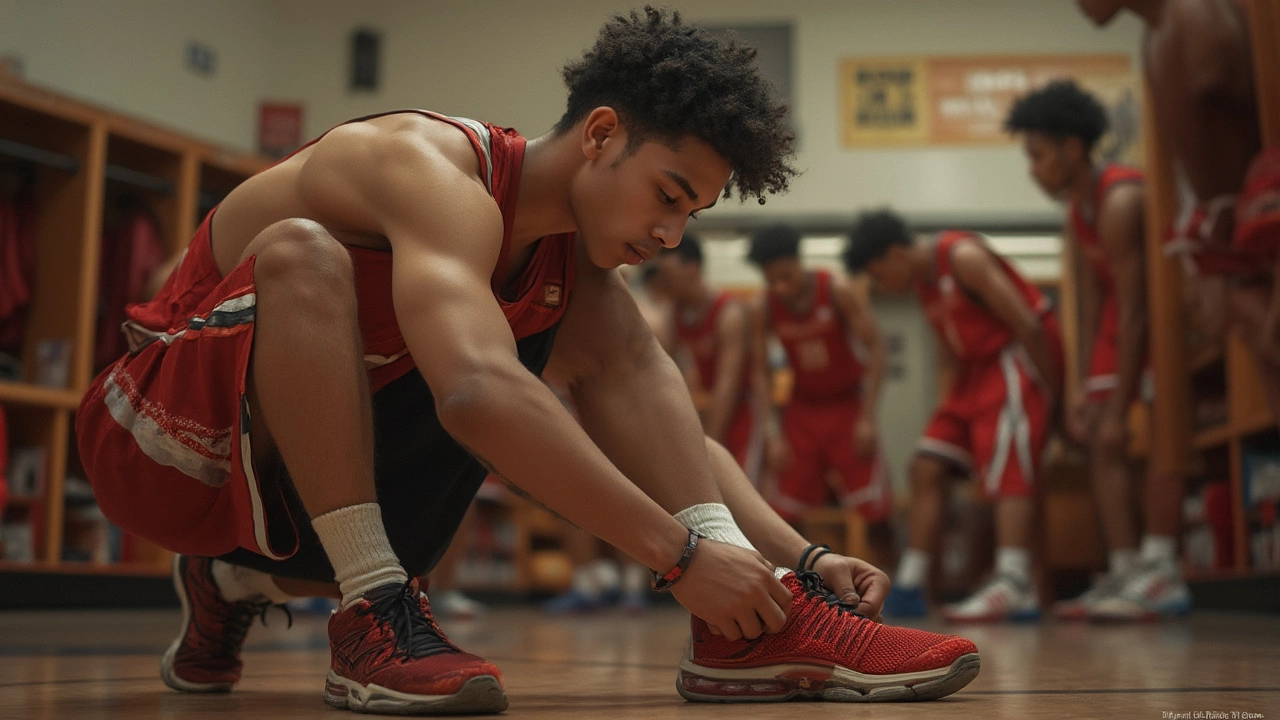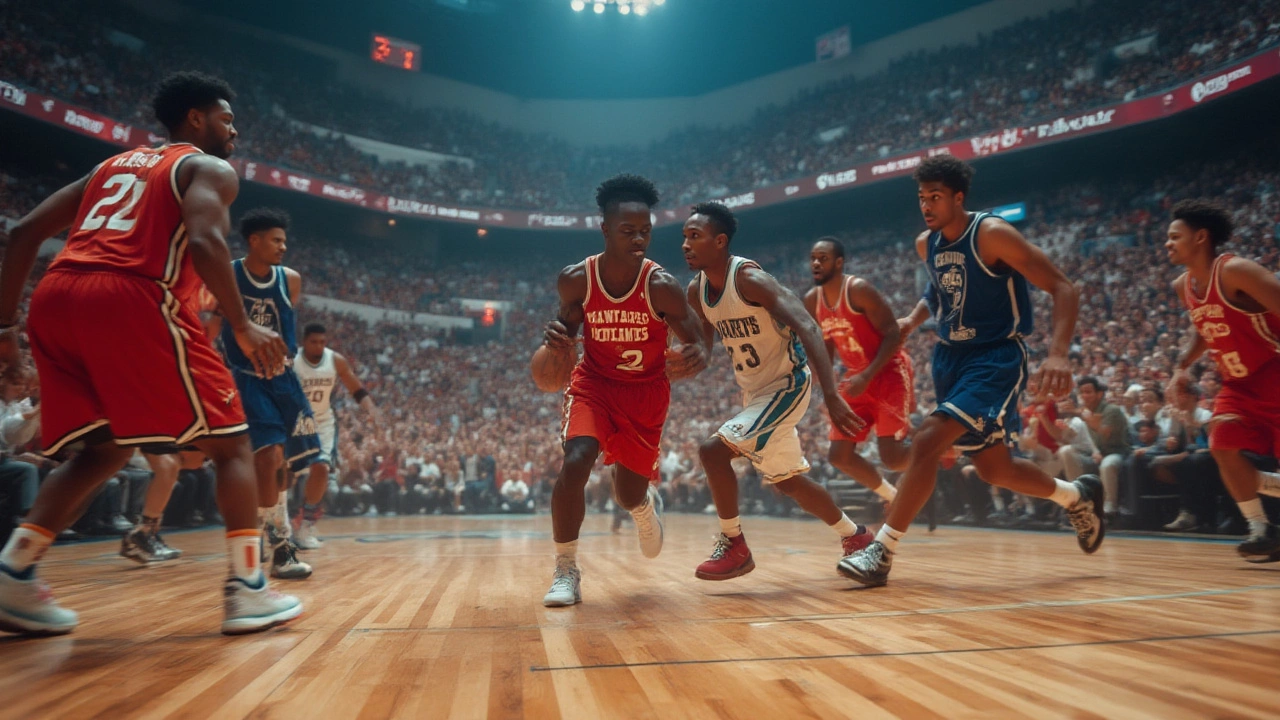Being under six feet tall? Most people would say you have no chance in the NBA. Yet, history proves otherwise. The shortest NBA player ever, Muggsy Bogues, stood at just 5-foot-3. No, that’s not a typo. He faced off with giants every night—and held his own.
If you think height alone controls your shot at basketball glory, the story of the shortest NBA player will flip your perspective. It’s not just about being tall; it’s about how you use what you’ve got. Bogues dominated with speed, quick thinking, and pure hustle. Opponents found it tough to predict or contain him. Fans loved his fearless attitude. He racked up 39 blocks in his career, including one against 7-foot-tall Patrick Ewing. Talk about guts.
- Breaking the Height Stereotype
- Meet the Shortest NBA Player Ever
- Other Notable Short NBA Players
- How Height (Really) Affects the Game
- Tips for Shorter Players
- The Legacy of NBA’s Shortest Stars
Breaking the Height Stereotype
If you ask a random person to picture an NBA player, they’ll probably imagine someone at least 6-foot-6 with crazy reach. But the league has never been only for super-tall guys. There’s a long-running myth that you have to be nearly seven feet tall to even get noticed—but it just isn’t true.
Let’s look at the numbers. The average NBA player today is about 6-foot-6. But plenty of stars have played well below that “average.” Here’s a quick look at NBA players 5-foot-9 or shorter who made the cut:
| Name | Height | Years Active |
|---|---|---|
| Muggsy Bogues | 5'3" | 1987–2001 |
| Earl Boykins | 5'5" | 1999–2012 |
| Spud Webb | 5'7" | 1985–1998 |
| Nate Robinson | 5'9" | 2005–2016 |
You see these heights next to the names and realize: being short didn’t lock these guys out. They broke through with pure skill and confidence.
It’s easy to get hung up on numbers and forget that teams look for impact, not just size. The NBA has always valued quick reflexes, smart decision-making, and leadership. Shorter players often have the edge on speed and ball-handling, giving defenders a headache.
If you’re thinking of trying out—no matter your height—the shortest nba player’s story proves the stereotype can be smashed. What really matters? Skills, hustle, and heart.
Meet the Shortest NBA Player Ever
Muggsy Bogues grabs the spotlight when you think of the shortest NBA player. Born Tyrone Curtis Bogues in 1965, he stood just 5’3” (1.60m) tall—but played 14 seasons in the NBA. He was picked 12th overall in the 1987 NBA draft by the Washington Bullets, which is wild considering almost every other player towered over him by at least a foot. He spent most of his career with the Charlotte Hornets and became a fan favorite thanks to his energy, court vision, and quick hands.
As a rookie, Bogues already made headlines. By his third season, he was leading the Hornets in assists and steals. Defenses couldn’t pin him down. Despite his height, he could dribble circles around much taller opponents and set up scoring plays like nobody else. In fact, Bogues averaged over 7 assists per game in seven different seasons. He even snagged a few blocks—39 total, which may not sound like much until you realize he was blocking guys literally twice his size.
If you look at the stats, here’s how Muggsy measured up:
| Stat | Career Total | Best Season |
|---|---|---|
| Points | 6,858 | 11.1 ppg (1993-94) |
| Assists | 6,726 | 10.7 apg (1993-94) |
| Steals | 1,369 | 2.1 spg (1990-91) |
| Blocks | 39 | 7 |
During his career, Muggsy Bogues proved size didn’t have to hold you back on the court. He became a real inspiration—not just for short players, but for anyone told they "can’t." Muggsy’s secret wasn’t just speed. He brought leadership, basketball IQ, and a stubborn will to outwork everyone else. He didn’t just make the NBA; he left a lasting mark on the league and on fans who root for the underdog.
Other Notable Short NBA Players
Muggsy Bogues might hold the record as the shortest NBA player, but he’s not the only one who proved height doesn’t always win in basketball. Quite a few players under 5-foot-10 have hustled their way into NBA history, leaving their own marks. Here are a few names that stand out:
- Earl Boykins – Standing at 5-foot-5, Boykins played 13 seasons. He once scored 32 points in a game for the Nuggets, showing that size takes a backseat to skill and confidence.
- Spud Webb – Best remembered for winning the 1986 NBA Slam Dunk Contest, Webb stood at just 5-foot-7. He spent over a decade in the league and could dunk over players almost a foot taller.
- Nate Robinson – Also at 5-foot-9, Robinson built his career on sheer explosiveness. He won the NBA Slam Dunk Contest three times and had a playoff run with the Bulls where his energy changed games.
- Greg Grant – At 5-foot-7, Grant played for six NBA teams, proving that relentless effort keeps you in the league even if you’re the shortest guy on the floor.
Check out how these players stack up against each other and other NBA peers in terms of height and career stats:
| Player | Height | NBA Seasons | Career Points Per Game | Slam Dunk Contest Wins |
|---|---|---|---|---|
| Muggsy Bogues | 5'3" | 14 | 7.7 | 0 |
| Earl Boykins | 5'5" | 13 | 8.9 | 0 |
| Spud Webb | 5'7" | 12 | 9.9 | 1 |
| Nate Robinson | 5'9" | 11 | 11.0 | 3 |
| Greg Grant | 5'7" | 6 | 2.8 | 0 |
These guys never let height stop them. Their stories aren’t just about being short—they’re about grinding every day, finding their edge, and making the most of every opportunity. If you’re a shorter player wondering if there’s a spot for you, the path is tough but not impossible. It’s all about standing out in other ways.

How Height (Really) Affects the Game
Everyone loves to talk about height in basketball. Over 70% of current NBA players are listed at 6'6" or taller. But here’s the real talk—height isn’t everything. Sure, being tall makes shooting, rebounding, and defending near the rim much easier. Guards like Steph Curry (6’2”) prove skills can shake up expectations too.
Here’s a quick look at how player height mixes with main stats in the league:
| Height Range | Average Points/Game | Rebounds/Game | Blocks/Game |
|---|---|---|---|
| Under 6’0” | 8.7 | 1.8 | 0.08 |
| 6’1” - 6’5” | 12.5 | 3.1 | 0.23 |
| 6’6” - 6’10” | 14.9 | 5.6 | 0.80 |
| Over 6’10” | 13.4 | 7.9 | 1.83 |
All that said, the shortest NBA player ever—shortest nba player, Muggsy Bogues—averaged 7.7 points and 7.6 assists per game across his career. That’s solid, even compared to much taller players. His speed, vision, and court awareness evened out his height difference. Being short actually helped Bogues weave through defenders who struggled to catch his quick changes in direction.
NBA teams don’t just look for height. They go after reliable shooters, creative passers, and defenders who can read the court. Smaller players might not block as many shots, but they rack up steals and make plays others can’t see. Coaches and scouts know: skill, grit, and basketball IQ matter as much as the numbers on a measuring tape.
Tips for Shorter Players
Think you’ve got to tower over everyone to thrive in basketball? Don’t buy it. Standing a few inches shorter just means you’ve got to approach the game a bit differently—just like the shortest NBA player, Muggsy Bogues, proved night after night. Let’s get straight into some real tips that work.
- Speed and Agility: Shorter players have an advantage when it comes to quickness. Work on your first step and lateral movements. It’s no accident Muggsy Bogues and Spud Webb could dart around defenders. Quick feet can make up for a lack of height.
- Ball Handling: Keep that dribble low. A tight, controlled handle is crucial. NBA guards under 6 feet often practice advanced dribbling drills just to keep the ball away from taller, longer arms.
- Change of Pace: Throw off your defender’s timing. Use hesitations, crossovers, and sudden bursts to create space. Think about Allen Iverson’s famous “killer crossover”—it worked because defenders couldn’t predict his speed or direction.
- Efficient Shooting: Develop a reliable jumper, especially from mid-range or three-point spots. Shorter guards like Fred VanVleet worked endlessly to perfect their shot. You’ll need to shoot over outstretched arms, so muscle memory matters.
- Defensive Tricks: Use your size to your advantage. Stay low, keep your center of gravity, and become an annoying defender. Pressure the ball handler and use quick hands for steals, like Chris Clemons and Nate Robinson often did.
- Vision and Passing: Make up for lost inches by seeing the play before it happens. Muggsy wasn’t just fast, he knew where the ball needed to go before defenders did. Hours of practice with passing and court awareness drills make all the difference.
Here’s a quick look at some NBA players 5'9" and below, their height, and key stats that show how they overcame the height difference:
| Player | Height | Notable Skill | Career Points Per Game (PPG) |
|---|---|---|---|
| Muggsy Bogues | 5'3" | Passes, Defense | 7.7 |
| Spud Webb | 5'7" | Dunks, Quickness | 9.9 |
| Earl Boykins | 5'5" | Scoring, Ball Handling | 8.9 |
| Chris Clemons | 5'9" | Shooting, Hustle | 4.9 |
Bottom line: playing below the rim isn’t a weakness, it’s a style. Focus on your strengths, and develop your basketball IQ. The league’s shortest have shown everyone just how much a gritty, relentless approach can pay off.
The Legacy of NBA’s Shortest Stars
The impact of the shortest NBA player goes way beyond a quirky record in a stat book. Muggsy Bogues, at just 5'3", won real respect from legends and fans. He played 14 seasons, mostly with the Charlotte Hornets, and left a mark as a leader and a playmaker. He totaled over 6,700 points and more than 6,000 assists. That’s more than a lot of players who stood nearly two feet taller.
Earl Boykins, another big name among the league's shortest, carved out an 11-year NBA career at 5'5". He was never drafted but still managed to drop fifty points in a game for the Denver Nuggets. These guys proved that grit and smart basketball can go a long way, even against giants.
The influence of short players reaches far beyond the court. They’ve shown smaller athletes worldwide that pure height is not the only ticket to hoops success. Bogues, Spud Webb (5'7"), and Boykins went on to coach, mentor, and inspire kids who aren’t done growing yet. Their stories break down barriers and challenge old-school thinking about who belongs in the NBA.
Here are some ways the shortest stars have shaped the sport:
- Opened doors for players of all sizes, making the game more inclusive.
- Promoted fast-paced play and creative passing, which changed how some teams approach offense.
- Became fan favorites for their underdog spirit and never-quit mentality.
- Influenced youth basketball programs to value skill, speed, and heart as much as wingspan.
When coaches talk about hustle, vision, and perseverance, clips of Bogues, Boykins, and others aren’t just feel-good moments—they’re proof that limits can be shattered. For anyone who’s ever felt overlooked for being too short, these legends are proof that you don’t need to fit the mold to make history in the NBA.

